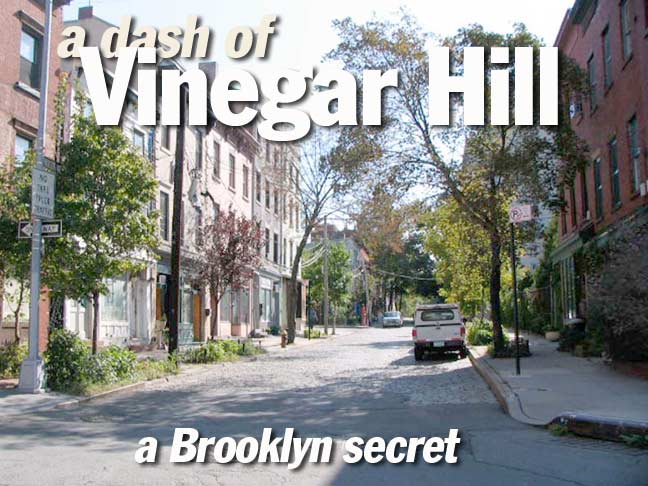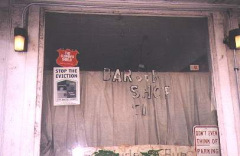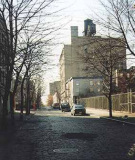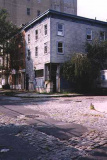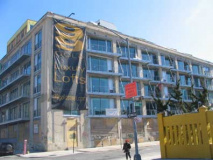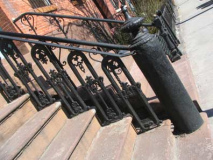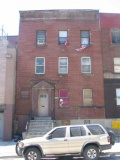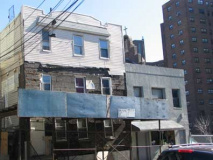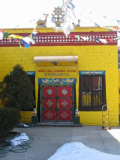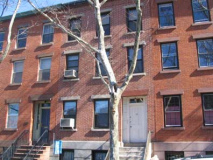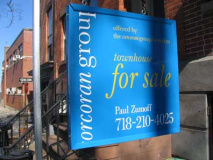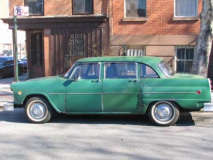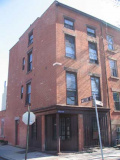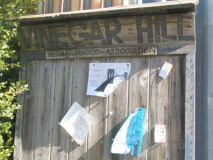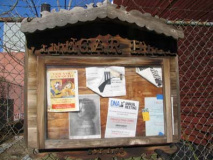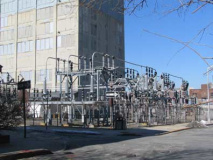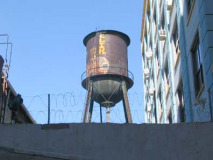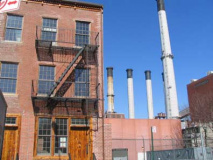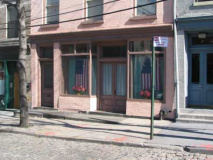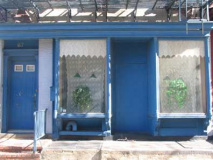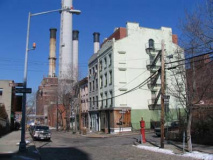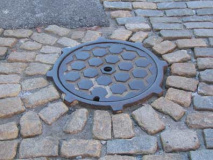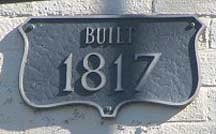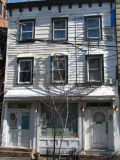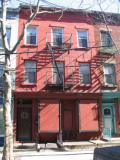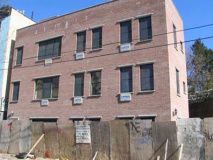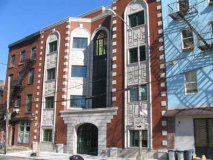Vinegar Hill is about a four or five block square neighborhood in Brooklyn located just east of the Manhattan Bridge anchorage. It’s a charming little area marked by brownstone buildings and Belgian-block streets that haven’t yet been asphalted. To the left we see the nominal main drag, Hudson Avenue, on a cold winter Sunday. Other than a couple of groceries and bodegas on Gold and Bridge Streets, residents have to travel west to Brooklyn Heights or south to the new MetroTech area for amenities.
Vinegar Hill is all that is left of a rather more extensive brownstoned area. But it was gradually decimated by the construction of the nearby Brooklyn-Queens Expressway and the Farragut Houses south of York Street in the 40s and 50s.
The story of how Vinegar Hill got its name is an unusual one. For one thing, it’s not named for vinegar at all.
In 1800, a John Jackson purchased the land on which the neighborhood would later arise from the Sands brothers, for whom Sands Street is named. Jackson hoped to attract Irish immigrants and named the tract Vinegar Hill after the site of a fierce battle in the Irish rebellion of 1798. In Ireland, the name “Vinegar Hill” was an English transliteration of a Gaelic (Irish) term meaning “hill of the wood of the berries”.
Vinegar Hill has also been known as Irish Town in the past.
It looks like Brooklyn as it was in the late 1800s…but it’s 1999 in Vinegar Hill. [for descriptions, click on thumbnails]
Forgotten Fan Dale Rejtmar, a Vinegar Hiller, writes:
Most of the residences were built between the late 1820s and the 1850s, the latter ones reflect the Italianate style. The 3 story blue colored house in the [photo at left] was constructed sometime between 1828-41 (this information is based on deeds and city directories). So, it’s probably more accurate to say something like “It looks likeBrooklyn as it was in the mid 19th Century.
Hudson Avenue and Water Street.
2006 update: getting a bit sour
Some of the DUMBO building boom is leaching over to Vinegar Hill, and some of the results aren’t pretty. While there’s still a Vinegar Hill to chronicle…here’s what it looked like in 2006.
Front Street between Bridge and Gold has some of Vinegar Hill’s last remaining attached brownstone buildings, complete with ornate iron railings and boot scrapers. But change is afoot as luxury condos are underway on Gold Street.
If the swells move in they’ll have to deal with a couple of eyesores on Gold Street, as well as the presence of the forbidding Farragut Houses, though they don’t seem to be the impediment they used to be to development.
I seem to recall this Buddhist temple at Gold and Front being a used car lot. A little barbed wire — well, a lot– still isn’t a bad idea around here.
More remaining brownstones on Gold between Front and Water. A couple are for sale…for far above reasonable prices.
At Gold and Water you find a corner building with 3 sets of street signs: a remaining blue enamel Gold St. sign over the door, a chiseled pair further up the building, and modern signs on the sidewalk. A checker cab stripped of its yellow paint and checkers, then painted green, completes the scene.
(A few blocks south of Gold and Water Streets, you will find Johnson Street. LBJ won the election against challenger Barry Goldwater in 1964)
Vinegar Hill boasts small-town touches like community bulletin boards…
..but it’s truly an isolated neighborhood, separated from rebuilding DUMBO by a few blocks of barbed-wire desolation and the massive Con Ed plant, in which no cameras may go, looms over all.
The contrast between Water Street’s little 3-story walkups and the massive Con Ed smokestacks is too good a photo op to pass up.
Hudson Avenue
Hudson Avenue is a true Brooklyn anachronism. It formerly extended south from the East River in a continuous route all the way to Fulton Street near its junction with Flatbush Avenue, as one of the community’s main streets–even boasting an el, as the Fifth Avenue el shadowed it on its way down to Park Slope and then Bay Ridge. However, most of Hudson Avenue was obliterated after the el came down in 1940 by the construction of a series of housing projects, the Farragut, the Ingersoll and the University Towers Houses; only its Vinegar Hill stretch and a short block between DeKalb Avenue and Fulton Street remain. Ah, why’d they name a road that goes to rthe East River Hudson Avenue, anyway?
As we’ll see Hudson Avenue retains touches of its formerly loftier status.
Hudson Avenue is lined with unsued storefronts, that must have had a practical use at one time. These days residents just put plants and flags in the windows.
Like other isolated parts of the city Vinegar Hill has retained its ancient flagstones, Belgian blocks laid down in the mid-to late 1800s and never macadam’ed over. Unusually the stones were laid in a circle around the manhole. Which came first?
The date of construction of the building on the left is found on a plaque under the 3rd story window. All 3 buildings, complete with unused storefronts likely added later, were probably built in the same era.
Ah, but as we’ve seen, change is coming to Vinegar Hill with cheap construction on Hudson Avenue’s southern stretch near the Farragut Houses. There’s the requisite Friedrich’s Special and a neo-classical at Hudson and Front. Hold the soul, please.
The one on the right is particularly heinous because there used to be an open space here that allowed you to look at the 1807 Commandant’s House in the Navy Yard. The only view now is way behind a big iron gate on Evans Street.
4/30/98; revised 2006

